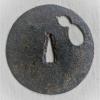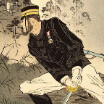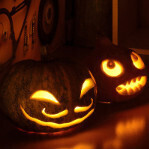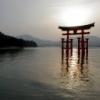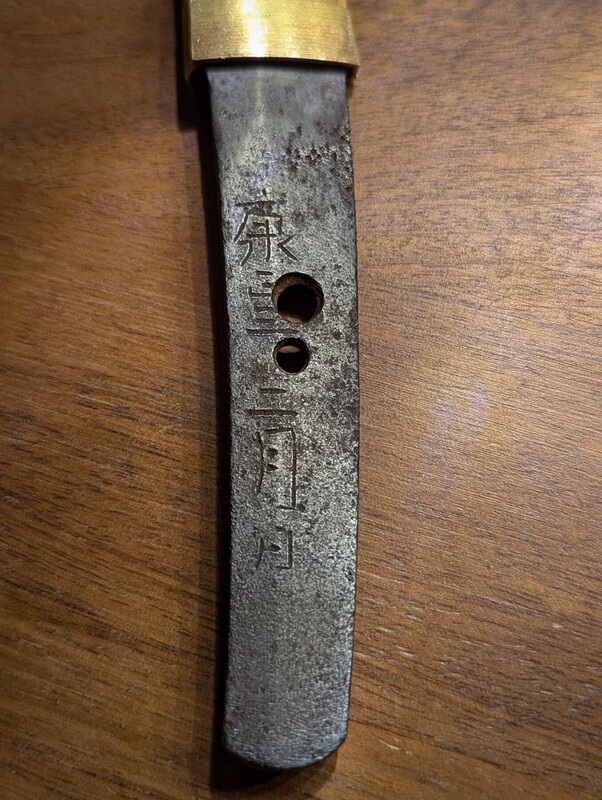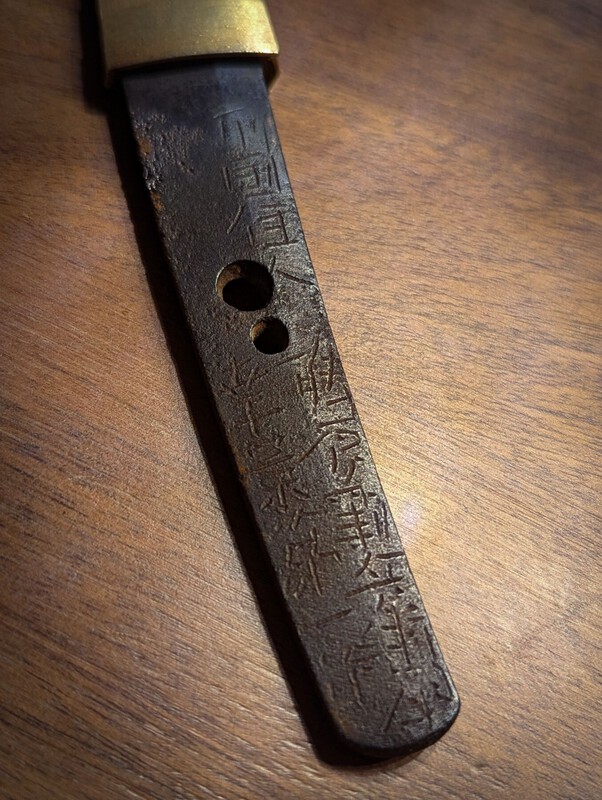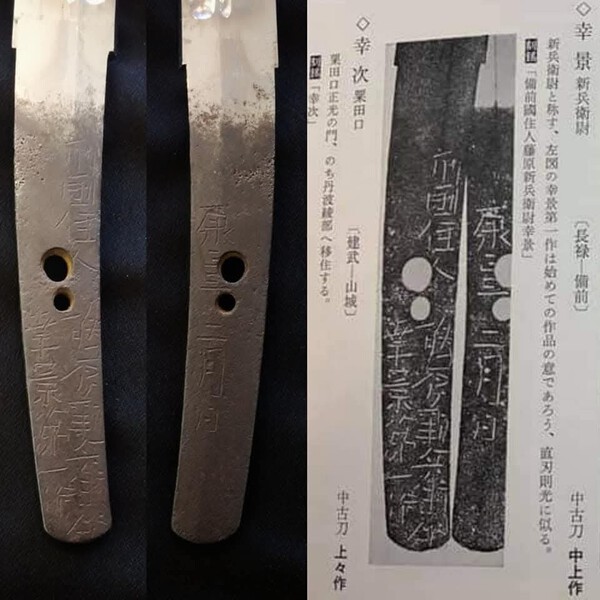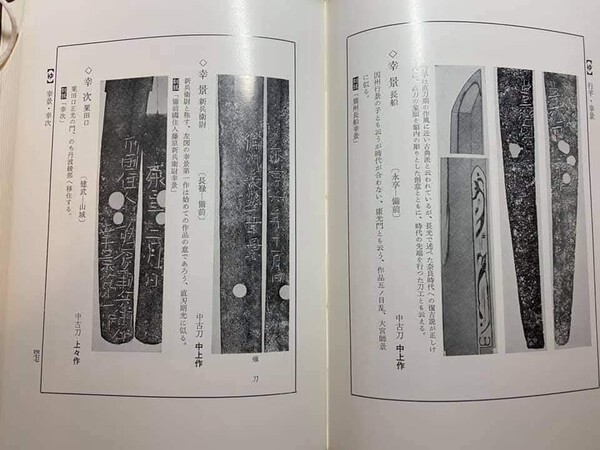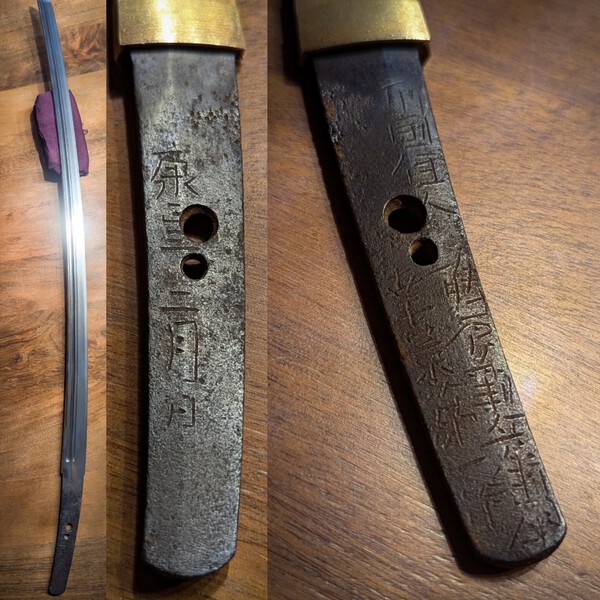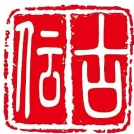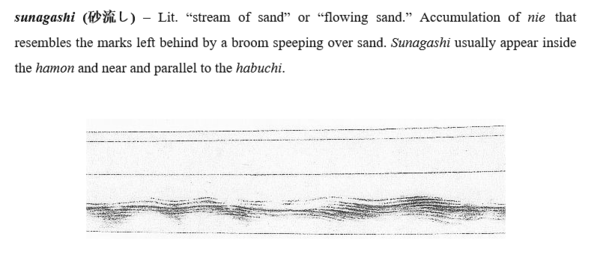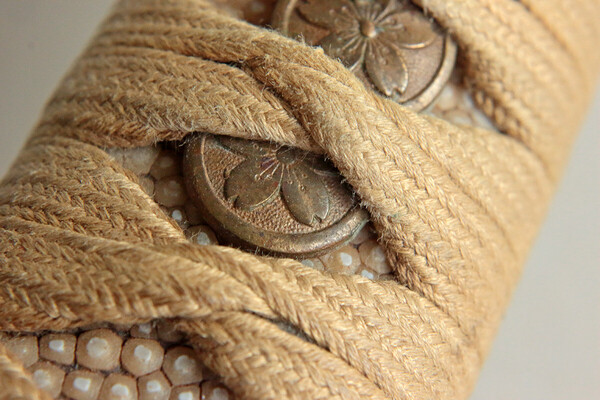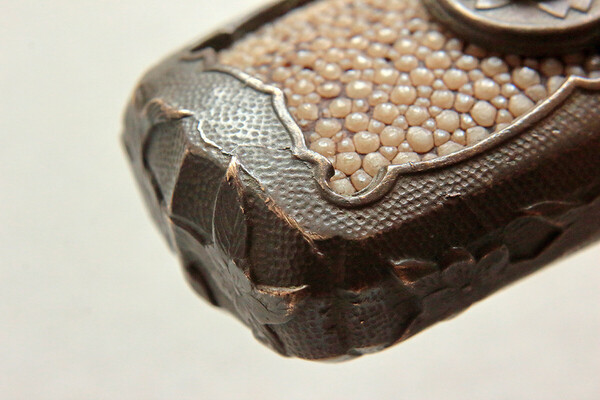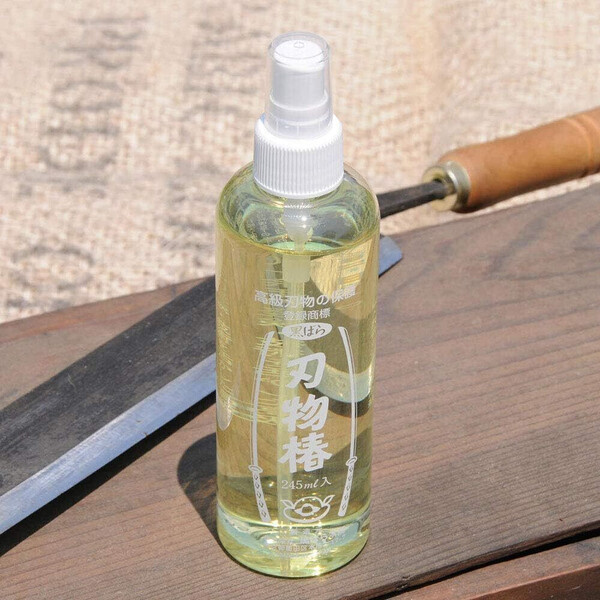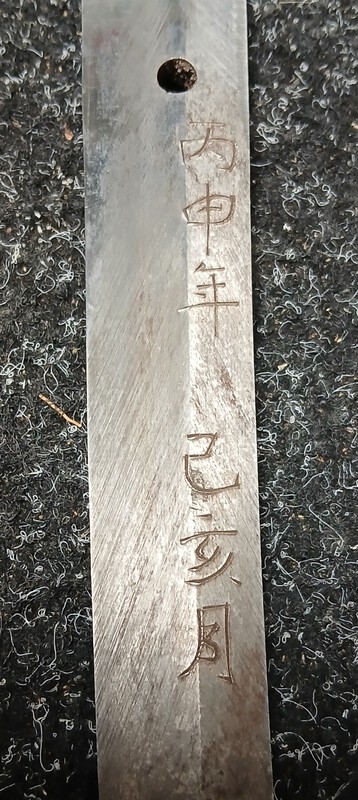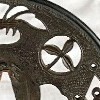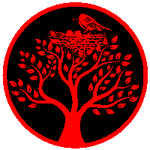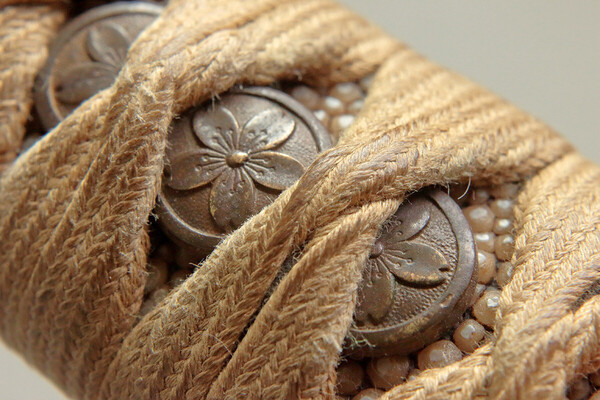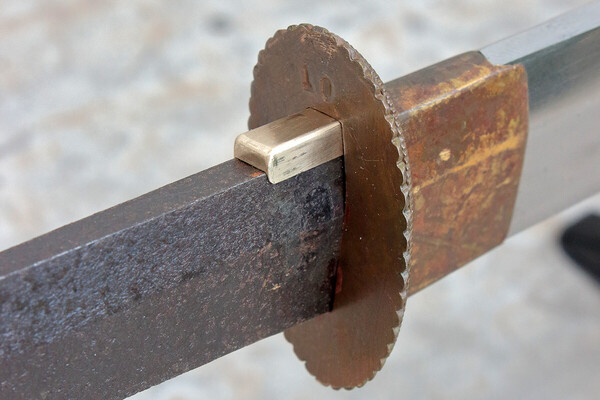Leaderboard
Popular Content
Showing content with the highest reputation on 06/06/2025 in all areas
-
The blank of soft metal TSUBA is always cast with the exception of MOKUME GANE. Some are completely cast with decoration included, some of those are reworked then manually, and finished. A bunch of different techniques. Ford Hallam has often explained this.4 points
-
It is a modern Chinese made sword. Nothing fake about it and not meant to deceive. A very nice gift indeed. 友澤作 = made by Yǒuzé. 利長磨 = polished by Lì zhǎng. 丙申年 = 2016. 己亥月 = November (more or less). Sources consulted in the translation above. An absolute beauty of a Longquan Katana. Sexagenary cycle3 points
-
The HAMON looks strange to me. I am not sure if it is traditionally made or artificially applied. The NAKAGO seems very evenly corroded which is unusual for such a young blade. Loose parts like a rattling TSUBA can be fixed with traditional Japanese methods.3 points
-
This is very interesting. It definitely indicates that cast tsuba were being made in the 17th century, but only gives evidence for non-iron cast tsuba. It would be interesting to see whether there is any evidence or examples of cast bronze/brass/shakudo tsuba survive. Particularly, it would be interesting to catalogue the fragments of moulds found, and see if those can be matched to any existing tsuba, iron or not. I love archaeology :-)3 points
-
3 points
-
CLUB UPDATE: We've got 16 members (and counting!) in the PNW that have signed up to join the club. That's more than I anticipated, which is great! I think that's plenty of people to justify the club, and plan annual meetups. I hope to have a flier on a club members table at the SF swordshow. Hopefully to scrounge up some more local membership. After the SF show, I will be booking a meeting space, and scheduling our first meeting hopefully in the fall or winter. Stay tuned in AUGUST for meeting dates and details. Thanks again everyone, -Sam3 points
-
I'd say in this (rare) case, the blade predates the bone fittings, and is a genuine Nihonto, remounted later. I would actually take it out of those, which don't do it justice, and put it into shirasaya.3 points
-
For the nakago, IF you must prevent red rust, put a drop or 2 on your fingertips, and lightly massage it onto the nakago. One or 2 drops is more than enough. Some say do nothing, but sometimes I feel the nakago can use just a little oil.3 points
-
A fine Bizen Yukikage wakizashi with a deep sori and slender, graceful sugata that resembles a kodachi. Tokubetsu Hozon and published in the famous Fujishiro Toko Jiten. YUKIKAGE (幸景), Chōroku (長禄, 1457-1460), Bizen – “Bishū Osafune Yukikage” (備州長船幸景), “Bizen no Kuni-jūnin Fujiwara Shinbei no Jō Yukikage saku” (備前国住人藤原新兵衛尉幸景作), “Bishū Osafune Shinbei no Jō Yukikage” (備州長船新兵衛幸景), first name Shinbei (新兵衛), gunome-midare or suguha in nioi-deki, chūjō- saku - Markus Sesko $7,250.00 + shipping2 points
-
Indeed. Do people think that makers purchased milled billets of material to machine down on their fancy milling machines before they started work on them? Ford has shown how blanks were cast, before they started work on the tsuba. Showing how soft metal tsuba were cast really does add nothing to this original topic.2 points
-
That's the issue with this thread, as raised earlier (and I know I am contributing to the problem, but at this point, it's too late): all the interesting information is hard to find. The reference to that paper (cast sword fitting in brass) has been given at some earlier point. Just like the mention of cast iron items, like chagama, and the process of doing it (cast the cast iron, then decarburize, finish the surface, then patinate it). Cast iron tsuba are currently made by iai equipment maker Nosyudo, but I am not familiar with their process (I suspect it's similar to the one above). Reference on non-ferrous cast tsuba in Nara: 刀装具鋳型の三次元分析からみた近世鋳造技術の研究 (2018 年度科学研究費(奨励研究)研究成果報告書, 研究課題番号:18H00015)2 points
-
2 points
-
https://note.com/katana_case_shi/n/nf87e5c28feb4?magazine_key=m92e5a83d03ce Here's the winning works of last year's NBTHK contest2 points
-
Nobuie is speculated to have included Christian iconography in his works. We also know that stylized renderings are common and may not be intuitive in their intended meaning. Even if Nobuie were not a Christian, he mat have made it as a hidden Christian tsuba on commission for a high-ranking buke who practiced Christianity. That would explain the stylization of the motifs. And I would agree that rosary beads are common to both Christian and Buddhist practice. If that Nobuie we were discussing does have a somewhat hidden Christian symbol on the right side, it is a possibility that the Christian rosary is depicted on the left side. This rendering of the rosary is identical to the one I posted from the Iida-Koendo site, which has quite a few Nobuie and Kanshiro Nishigaki works. I would think this seller is reputable. There are well-known Momoyama works y Nobuie that feature distinctly Buddhist iconography such as the 8-fold path. We can’t very well ask him what his spiritual practices were, but he lived in a time when Christianity was being practiced and often simultaneously along with Buddhism since the eastern orientation is toward a “both/and” sensibility.2 points
-
2 points
-
2 points
-
My latest acquisition has arrived and it's a beauty. I think this Ohno tsuba may be a so-called hidden Christian tsuba because one with an identical composition is in the small tsuba collection of a Japanese museum dedicated to documenting the early history of Christianity in Japan. It was featured in a newspaper article in the Asahi Shimbun on "Hidden Christian Tsuba" (see the tsuba on right lower corner). My write up on the speculation that this tsuba contains Christian iconography hidden within Buddhist iconography and a few pics follow. I had the good fortune of being the only bidder willing to spend $112 for a truly wonderful Ohno in amazing condition and imbued with meaning. Height 71.2 mm, width 69.5 mm, thickness 7-7.6 mm at mimi (6.6-6.8 at seppa-dai), weight 116 gm. Compare with my Ohno kuruma tsuba (Momoyama Period).1 point
-
1 point
-
1 point
-
Hey folks, here's a fun one...i got this sword as a gift, and to my surprise the handle came off and the nakago is signed? The sword is armhair-shaving-razorsharp but hamon looks fake, maybe T10? (it is magnetic) Also a really old iron tsuba is fitted, the koshirae looks and feels new-ish unfortunately.1 point
-
I can't see anything wrong on these images. Looks fine for me. I don't think this design would be cheap and easy to copy.1 point
-
1 point
-
I had to dig into this one as I was puzzled by the first character. The last name Mori is a single character yet this has two characters preceding Kaneharu. I had to use this older NMB thread from 2012 to figure out what the first character was. Special thanks to @k morita for the character identification. Nantoka Kanenori Translation 関森兼治 = Seki Mori Kaneharu [with partial 昭 stamp above?] Old to New Looks more like the new version than the old one; however, .... 關 = 関 @mecox1 point
-
Frank, that blade is probably not Japanese. The signature(s) (= TACHI MEI) make no sense to me. What remains of the Japanese TSUBA cannot be sold on the market. It may not be very old (how old is old?), but very corroded. The FUCHI is not genuine, but the TSUKA looks to be a repurposed original one. As it is a gift, there were certainly good intentions involved. Don't kill the spender!1 point
-
Hello. why have you posted this on the end of an old topic? Much better if you start a new topic. I doubt you will get any replies doing it this way.1 point
-
1 point
-
"Army gunto always have white rayskin, and Navy kaigunto always have black rayskin." We've seen a couple of kiagunto recently with white same'. I started a thread to track them, but have forgotten to follow up. I just saw another over at Leo Monson's house. Next week, I'll get photos and add to this post. Also, have recently seen Army gunto with black rayskin. Here is one of them, posted by @kotkinjs1 This one posted by @PNSSHOGUN1 point
-
First and only reduction: Tosho: EUR 100 The other one EUR 80.1 point
-
If you are not in a very wet environment you can avoid oil. It's that i do for decades.1 point
-
Nothing to do with the Shanghai dagger. I collect FS quite seriously, and any resemblance here is purely co-incidental. I don't see anything here arguing for wartime production. There are literally thousands of assorted knives made for commercial sale in the 50's and 60's from small factories. I suspect the handle was a later addition, likely the original one perished and was replaced by a simple turned one. Has a newer look to it. Certainly nothing that was ever made in any great quantity or used in any official capacity. Could have been made by any small Japanese maker making for the export market in the 50's. There was a prolific market back then, which was later capitalized on by people like Pete Gerber, Al Mar, Kershaw and others.1 point
-
1 point
-
Your wakizashi paperwork is from the NTHK, the Nihon Token Hozon Kai, quite a well-known certification body, if not quite as trusted as the NBTHK. I have a crick in my neck recently making this a pain, but... The first line from the right notes the smith Mei as signed. The next line descrbes the 'tsukurikomi' as Shobu-zukuri, iori mune and ubu nakago. Then kitae: O-itame Then hamon: Choji midare Then for the boshi: Midare komi, maruku kaeru Then 1 mekugi ana, and nakago filed in sujikai. Period: Around Kanei (Not sure what 別家 means, possibly 'a different branch' Tameie, not the main family?) PS Written in a rush. Forgive any oversights!1 point
-
David, I see a yakiba (the whitened area along the edge) but I don't see even a glimmer of a hamon in any of your photos. I agree the habaki is very nice and the gold on the tsuba/o-seppa suggests a better class of bone koshirae, however, I see a tired, worn out blade with possibly heat damage (i.e., has been in a fire). Look at the blade at a low angle along its length while pointing it at a single light source. If there is a hamon it should 'pop' under this lighting. If not, its what I would consider a 'dead' sword and in those mounts still a tourist souvenir and I doubt worth the cost of a shirasaya. Get thee to a To-ken Society or local sword group meeting and show it around. BaZZa.1 point
-
1 point
-
1 point
-
Thank you for the translation! I wasn’t expecting it to be a Chinese City. I have more research to do.1 point
-
Thanks to our ignorant law……congrats are due elsewhere. Wonderful buy at that price. Ought to have been £10k+ and had it been 18thC maybe double that. I don’t think I’ll ever get rid of my inner seething regarding this “issue”☹️ ….and nor have I ever seen a Bizen yaki Kirin. I love Bizen yaki…..such a strong understated ceramic. It is also surprisingly affordable…..it’s a bit too wabi-sabi maybe for many?1 point
-
I have been talking with Wally Hostetter. He’s pretty responsive and has a wide range of stuff he can make. Decent pricing too. You can fill out a contact form on his website. https://shiningmoon13.com/contact-us/ just tell him what you’re looking for and he’ll give you an initial estimate. He doesn’t accept any electronic payments though. But, he does say you don’t pay until the work is done and he shows you pictures/video and you approve. After which you can mail send a check or money order.1 point
-
1 point
-
Your sword is signed 豊後住藤原輝行 - Bungo jū Fujiwara Teruyuki. I believe few generations of Bungo Teruyuki worked from c. 1650 to 1750.1 point
-
1 point
-
1 point
-
Do you have a photograph of the entire blade shape perhaps? I am a little confused by your question. Can you describe what looks wrong about the kissaki to you? Is it the lack of defined yakote YOKOTE? I suspect the sugata may be SHOBU ZUKURI, which is a blade shape that lacks yakote YOKOTE. See sugata types below: http://meiboku.info/guide/form/zukuri/index.htm Either way, the condition is not great as you note. That's not blood stain, but rather rust/pitting/corrosion. I do hear the 'blood stain' story in the wild pretty frequently; but it's never actually blood. Hope this helps, -Sam1 point
-
Yes, we have to get used to the fact that when we say "arsenal" or "machine made" or Showato etc etc, we mean not 100% traditionally made, and likely oil quenched. They were still made by a smith, could be forged and hammered (power or otherwise) but not considered Gendaito. Handmade? You could say that. But on a mass production and fast basis, and oil quenched. When we say Gendaito, it used tamahagane, and was water quenched. Excluding those odd swords that fall somewhere in the middle. But this one is oil quenched, and the stamp is a clear indicator that it is not a Gendaito, whether it would paper or not.1 point
-
In this context, handmade traditional sword-blades are understood to be made from TAMAHAGANE. The steel of these would have been purified by forging, folding, and fire-welding a number of times before being forged out to its final shape. Traditional quenching in water and polishing without machines would follow. This applies to GENDAITO and SHINSAKUTO. There is no rule about the use of a power-hammer: You still have to hold the blade and guide the action, so this is not considered as "machine-made". It all depends on the situation in your forge: If you have no apprentices, the power-hammer will help with the raw work. There were several methods to produce wartime blades. SHOWATO are made from industrial steel without folding and fire-welding. As far as I understand, there are rare exceptions to this. Modern alloyed steel cannot be water-quenched without a high risk of cracking. Oil-quenching generates a good hardness with little risk of KIZU, but does not produce HATARAKI in the steel as we see them on traditionally made blades. There will be no NIE formations, and the HAMON is rather plain and without much variation. If you compare a traditional blade and a SHOWATO side by side, this will be obvious. What you like and find interesting is a matter of personal preference and taste.1 point
-
1 point
-
1 point
-
1 point
-
I already had all dimensions, so it took only a couple of hours of work to shape a new brass wedge. I used simple tools like vises, a small hacksaw, a set of small files and a couple round sheets of automotive sandpaper from the local market. Another hour I spent making final adjustments, filing edges and sandpapering the wedge. I recreated all features of my original design, including tiny ridges that keep the wedge centered on the nakago. The foremost seppa has the smallest nakago-ana, so it has to be installed before the wedge. Then the wedge fixes it in the proper position. Then all other seppas and tsuba may be installed.1 point
This leaderboard is set to Johannesburg/GMT+02:00

